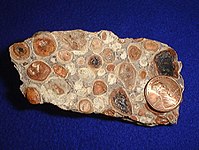
Photo from wikipedia
Incorporation of relatively minor impurity metals onto metal (oxy)hydroxides can strongly impact solubility. In complex highly alkaline multicomponent tank waste such as that at the Hanford Nuclear Reservation, tests indicate… Click to show full abstract
Incorporation of relatively minor impurity metals onto metal (oxy)hydroxides can strongly impact solubility. In complex highly alkaline multicomponent tank waste such as that at the Hanford Nuclear Reservation, tests indicate that the surface area-normalized dissolution rate of boehmite ( AlOOH) nanomaterials is at least an order of magnitude lower than that predicted for the pure phase. Here we examine the dissolution kinetics of boehmite coated by adsorbed Cr(III), which adheres at saturation coverages as sparse chemisorbed monolayer clusters. Using 40 nm boehmite nanoplates as a model system, temperature-dependent dissolution rates of pure versus Cr(III)-adsorbed boehmite showed that the initial rate for the latter is consistently several times lower, with an apparent activation energy 16 kJ·mol-1 higher. Although the surface coverage is only around 50%, solution analytics coupled to multimethod solids characterization reveals a phyicochemical armoring effect by adsorbed Cr(III) that substantially reduces the number of dissolution-active sites on particle surfaces. Such findings could help improve kinetics models of boehmite and/or metal ion adsorbed boehmite nanomaterials, ultimately providing a stronger foundation for the development of more robust complex radioactive liquid waste processing strategies.
Journal Title: Environmental science & technology
Year Published: 2020
Link to full text (if available)
Share on Social Media: Sign Up to like & get
recommendations!